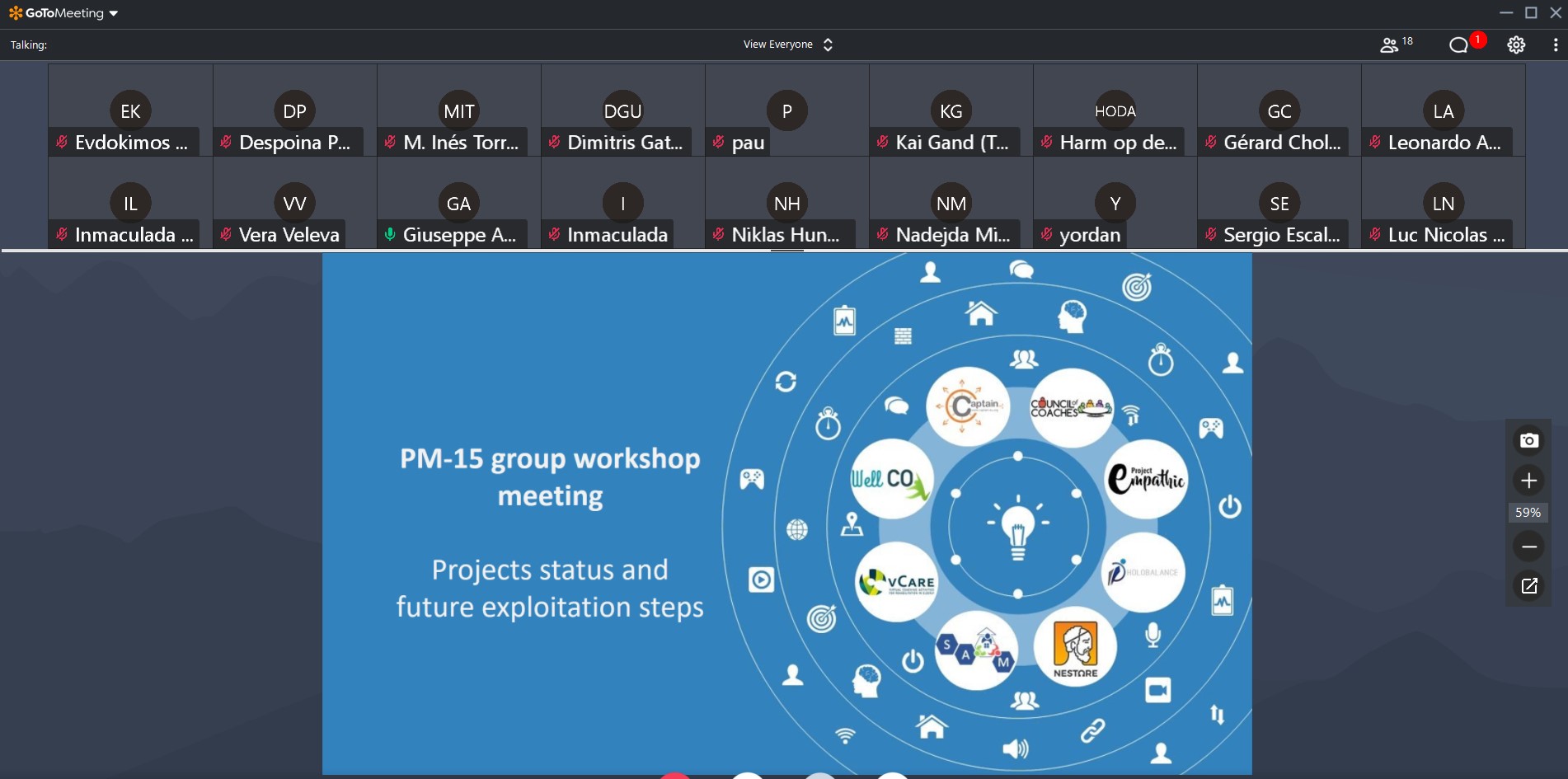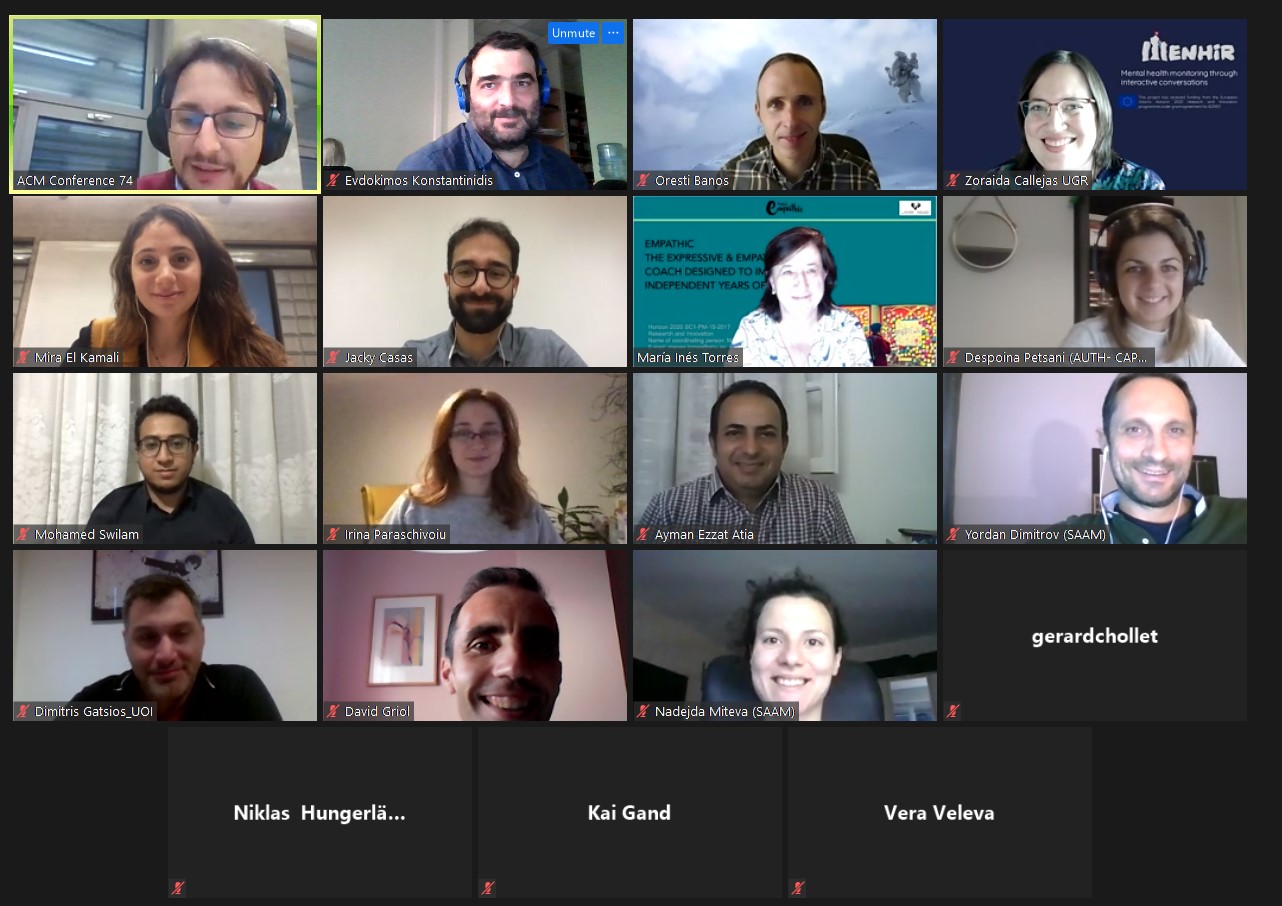PM-15 coaching alliance workshop on the impact of the COVID-19 pandemic
In order to perform effective and resilient research in the Health and Wellbeing domain researchers need 1) convenient access to research infrastructures, 2) direct engagement of people in order to validate hypotheses, co-design solutions and services, evaluate their feasibility and effectiveness and participate in the translation and mobilization of outcomes. The COVID-19 pandemic has affected various aspects of our everyday life and research activities did not remain untouched, especially in the Health and Wellbeing domain. The pandemic struck both pillars of the Health and Wellbeing research by restricting convenient access both to infrastructures and people.

PM-15 coaching alliance is a cluster of research projects in the health and wellbeing domain that were funded under the same H2020 call. The projects are developing and validating radically new ICT based concepts and approaches for empowering and motivating people in need of guidance and care due to age related conditions. The PM-15 coaching alliance is consisted of 8 projects, namely CAPTAIN, NESTORE, SAAM, vCare, HOLOBANCE, Council of Coaches, Empathic Project, WellCO. The PM-15 coaching alliance has organized and ran a workshop on 29th October 2020 in order to discuss the impact of the COVID-19 pandemic in projects’ activities and create a unified contingency and action plan. It is important to notice that all projects are reaching the end of their implementation period and the activities that are planned at the current time are based on user evaluation and testing. Given the discussion and insights from the PM-15 coaching alliance workshop, the impact of the pandemic can be summarized in 4 main axes.
Impact on end-users
All the projects of the PM-15 coaching alliance have adopted new, innovative methodologies for the design and evaluation of their technologies involving end-users. Our primary end-users are in all cases older adults that are the most vulnerable population in this pandemic while secondary users like healthcare professionals and informal caregivers are also strongly affected. After the first wave of the COVID pandemic, the consortia tried to restart their activities and engage people in face-to-face sessions, taking all the precautions and measures. However, on one hand, many participants were reluctant to join any activities due to COVID-fear and loss of interest. Most projects and institutions faced large number of dropouts. On the other hand, different measures were imposed in different regions forcing each consortium to create distinctive plans for multi-national testing.
An alternative solution that was used by many researchers was the transfer of face to face testing and evaluation to online sessions. Although this was an obvious solution for most events, for our end-users’ population there are major obstacles. Based on our experience, older adults face difficulties in using tools like skype or zoom for online meetings while some may not have internet access. The percentage of older people that are not familiar with the internet vary among different countries in Europe (The Digital Skills Gap in Europe). Regardless the percentage, the researchers must investigate alternatives in order to ensure inclusion of all participants.
Another impact that should be taken carefully into account is the polarization of data. The new everyday reality that all the world has been submitted to, affected several domains like social life, physical, cognitive and psychological state and nutritional habits. These are the domain that PM-15 projects also target to improve. It is crucial but at the same time very difficult to investigate and understand the counter effect of the pandemic and the newly introduced ICT systems.

Impact on access to research infrastructures
As research infrastructures we consider any physical space that allows the gathering of research data. For PM-15 projects research infrastructures include spaces in each organization where sessions are held, clinical settings in care and nursing homes and hospitals and even the end-users’ houses. Regarding clinical settings that accommodate older adults on a daily basis, the access become restricted in many cased while in other cases specific protective measures are taken. Regarding older people homes the access is very restricted. The reason is twofold, people reluctance in letting you in their homes and researcher’s fear of unintentionally infecting the participant.
Impact on ethics
Some consortia partners faced an impact on ethical approval procedures as tele-working caused delays in local ethical boards. Furthermore, local ethical committees asked for reassurance and additional measures to be reported regarding the safety of the participants. As the situation is getting worse and most European countries are experience the 2nd wave of the pandemic, there is the possibility that local ethical committees request to stop research activities with older adults. In the view of such a possibility all projects have difficulties in creating a coherent plan to follow.
Impact on researchers
Last but not least, the pandemic restricted traveling and in most cases make it impossible to organise face to face meetings. Face to face meetings have proven to be more effective in solving major issues and taking strategic decisions for a project as well as accelerating technical implementation. In large, distributed consortia the integration of different technical components in order to create a unified solution is very challenging when it should be done entirely online.
Solutions and Risk mitigation
The uncertainty caused by pandemic in all aspects of life, complicates a lot the planning and the creation of a risk mitigation strategy. As a first measure, most projects has extended the implementation period by 3-6 months. At the same time, all consortia try to re-schedule their activities and find alternative ways of performing testing with real users. The adjustment of goals to be achieved is inevitable and many considered reduction in the testing period as well as the means of testing. Ways to replace the face to face testing with online sessions were discussed but everyone agreed that nothing can replace the personal interaction. Even if every consortium creates a very well thought alternative plan, nobody can be sure what the situation will be like in some months from now.
Every consortium’s goal and expectation is to perform a well-designed evaluation and gather valuable feedback to improve the system that they have committed to deliver. Nevertheless, this requires more and more resources and the situation becomes riskier. The question that arises is what level of compromises should be made in order to balance safety, quality research and resources.


Comments ()